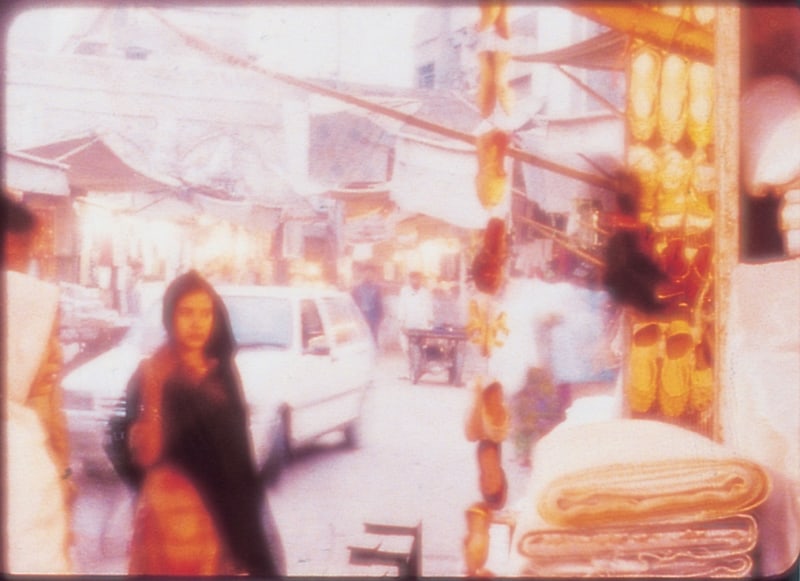
London-based artist Alia Syed presented two new films and a photographic series at New York's Talwar Gallery in late April. The exhibition's centerpiece, the 16mm Priya (2007-2008), captures a whirling, dancing figure in vivid colors that Syed created on the film by burying successive prints in the compost pile in her garden, allowing the organic material to tarnish the film. A graduate of the University of East London in 1987 and Slade School of Fine Art in 1992, Syed has created 10 films that bridge experimental cinema and fine art. On a sunny morning, the day before her show opened, ArtAsiaPacific caught up with Syed to discuss her new projects.
Filmmaking is a branch of art practice and there's also pure cinema. Where does your work fit in?
In school, we watched avant-garde films by Stan Brakhage, Michael Snow, Peter Gidal, Liz Rhodes, Martha Haslanger and Sun Friedrich. But my work doesn't follow any specific trajectory. I am interested in the material and the process of filmmaking and in the film as a crafted thing, either constructed or deconstructed. My practice is related to the language of editing, the creation of narratives and the notion of truth.
You make your works on film but often screen them from a digital projector. What's your thinking beyond whether to show work in a digital or an analog form?
For the 2006 Biennale of Sydney, I exhibited Eating Grass (2003), which is a 16mm film, but I handed the curators a DVD. I wanted to show a 16mm version, but I was told, "We've got 16mm artists, so you have to do something different." In the gallery setting, a 16mm projector is a rarified object so there's an inevitable romanticization. Of course, 16mm feels different from video, the same with light and sound. I've worked a lot with sound, which is as important as the image. But 16mm optical soundtracks are not very good. I show both Swan (1989) and Fatima's Letter (1991) as 16mm loops. But because of the sound, I show Eating Grass either on a digital projector or 16mm projector. I don't take the hard-line, I'm not a purist.
Do you set out to make a cinematic work, versus something that would be better shown in a gallery?
For me, cinema- or the notion of the cinematic- has something to do with space, not necessarily physical space. It's more like a psychological space that envelopes you. It's much easier to create that kind of space in the cinema, but it's possible in the gallery as well. The cinematic experience can be found in a photograph or painting or even a sound installation.
Your films are multi-layered, what's the process of creating them?
I start with an abstract idea, and then it manifests itself in the material. That collision of ideas and the material dictates what direction to take. With film, you never really work in isolation. You're always collaborating with technicians, even if you finish the film yourself. I'm not into this notion of film as a pure art form.
Would you explain the subject of Priya?
The woman dancing in the film is Priya Pawar, a Kathak dancer. Kathak is not an exclusively Indian classical dance; instead, Muslims took a religious Hindu dance form and transformed it into secular entertainment. It's a mix of different cultures - very syncretic. I also like the power the female dancer has, but the film became too literal and too exotic, too easy and too beautiful. I didn't really know what to do with it. Then I decided to bury it in the compost pile in my backyard, allowing the stuff I throw away to produce much of what you see in the film. This addresses the nostalgia and allure of images and of the film itself.
The process of making the film is very evident in your work. Can you explain what viewers are looking at?
When you edit the film, it's customary to make marks on the film with a chinagraph pencil. I retain those marls, even though when you make your final cut, you're supposed to remove the chinagraph marks because they get in the way and can scratch.
You mentioned that you write. How does that relate to your filmmaking?
It's a parallel activity, not a separate one. I've always written stories and poems, although, Priya is more like a diary. It's not an autobiography, but more like a biography than any other piece I've made. For A Story Told, I did a lot of historical research; the main character is a time traveler. I was reading Muslim philosophers such as Ibn Khaldun, a 14th-century Tunisian jurist and sociologist. He got exiled from many different courts and finally settled in Egypt. He sent for his family but they drowned at sea. I wondered what if one of his daughters hadn't drowned at sea, and she became the main character in A Story Told. Then she suddenly shows up in contemporary England, where notions of boundaries and migration- illegal immigrant- become relevant.
Are there topical subtexts to your work?
Yes, but not by design. I live in New Cross Gate in South London. After 9/11, there was this terrible paranoia, which translated into an immense amount of control. Everybody wants to control everything, and that's why governments were created. In New Cross, there are always transport police with sniffing dogs. If you don't have a ticket, they ask you where you live. It's immigration control, and it's intimidating. That's the environment we live in, so obviously, that's what the character responds to in A Story Told.
-The Editors, AAP